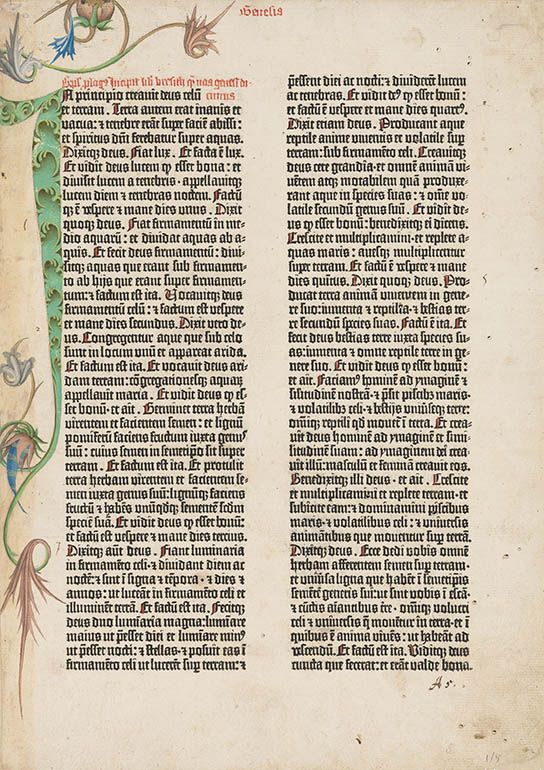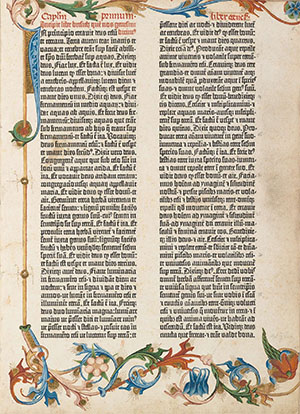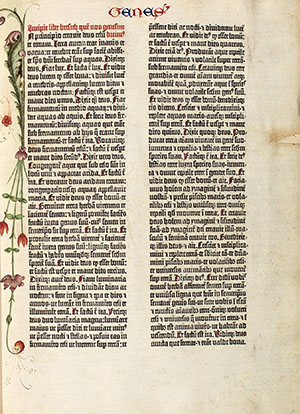Genesis 1:1, folio 5, recto. From the Morgan Library
62
The Forty-Two Line Bible
Johannes Gutenberg
Movable type was around long before Gutenberg. Bi Sheng (毕昇) was printing with ceramic type in China ca.1040 AD. Choe Yun-ui (崔允儀) used metal type to print the Sangjeong Yemun (詳定禮文) in Korea in 1234. Laurens Janszoon Coster, in the Netherlands, was reportedly printing with wood and metal types as early as the 1420s.
So, if Gutenberg didn’t invent movable type, what exactly made him such a big deal? The answer that is he was the first to solve all of the technical steps necessary to make printing economically feasible. He perfected a usable press, developed an oil-based ink suitable for metal type, and perhaps most importantly, invented a simple hand-held mold that allowed hundreds or thousands of individual pieces of type to be cast from a single matrix. His process, which remained essentially unchanged for 500 years, may very well be the most important invention in history.
Johannes Gensfleisch zur Laden zum Gutenberg was born sometime between 1398–1400 in Mainz, Germany, and after an early life that is, at best, poorly documented, ended up living in Strasbourg.1 Here he became a successful gem cutter and metalsmith, and as later records suggest, began secretly experimenting with printing from movable type, perhaps as early as 1436.
In 1439 he formed a partnership with Andreas Dritzehen and Andreas Heilmann to manufacture and sell polished mirrors to the pilgrims who would be visiting Aachen. The pilgrimage was postponed for a year and Gutenberg could not repay his partners. To satisfy them he shared with them his printing experiments, or, as he obliquely referred to it, simply Kunst und Aventur (Art and Enterprise).
By the mid-1440s Gutenberg was back in Mainz and he had apparently resolved most of the technical issues with his process. He set up a shop at Hof Humbrecht and began printing: an astronomical Kalender (1448), the German poem Das Weltgerich (1452), Ars Minor2 (ca.1452), and later, indulgences for the Church.3 The shop was successful enough that Gutenberg was able to convince the wealthy moneylender Johann Fust (or Faust) for a loan in 1450. Peter Schöffer, a Parisian scribe and Fust’s future son-in-law, also joined the enterprise.
Genesis 1:1, folio 5, recto. From the Universitätsbibliothek Göttingen
Genesis 1:1, folio 5, recto. From the Bayerische Staatsbibliothek
Genesis 1:1, folio 5, recto. From Keio University
In 1452 Gutenberg began Das Werk der Bücher (the Work of the Book) – a printed copy of the Bible. Between carving the punches, creating the matrices, casting the type, composing the forms, mixing the ink, printing the folios and collating the signatures, the entire project took Gutenberg, Schöffer and perhaps as many as 25 apprentices and assistants nearly three years to complete.4 The approximately 180 copies of the book required more than 16,000 pieces of type,5 49,000 sheets of paper and 11,000 sheets of vellum. The completed manuscripts were sold (for 30 florins) undecorated and unbound and the buyer, based on his finances, had the text rubricated, illuminated and bound (or not):
Ruth, folio 130, recto. From the Bayerische Staatsbibliothek
Near the end of Das Werk Gutenberg was deeply in debt and in 1455 Fust sued him in Archbishops court. Fust won the case and took control of the press as well as the remaining half of the completed books. Just as Gutenberg’s life’s work was being completed he found himself locked out of his own shop.
Fust quickly formed a new partnership with Schöffer and they became the first important printers in Europe (see here).
Gutenberg on the other hand spent the rest of his life one step ahead of debtors prison. With the partner Conrad Homery he opened a new shop and printed the 36-line Bible between 1458–60 and the Catholicon in 1460. He has exiled to Eltville in 1462 by Archbishop Adolph von Nassau after the sack of Mainz, only to have the Archbishop recognize his achievements three years later, when he was awarded the title of Hofmann. He died in Mainz on 3 Feb 1468.
In situ, NYPL, 22 Oct 20116
Gutenberg’s first typeface, the Donatus-Kalendar (or D-K) type, was used for the 1448 Kalendar, his editions of Donatus’ Ars Minor, as well as the later 36-line Bible. Gutenberg, with the assistance of Schöffer, modelled the type on a typical Northern European textura. To more closely replicate the appearance of a scribal page he designed not only a capital and lowercase Latin alphabet, but went to the additional trouble to make ligatures and scribal abbreviations – 202 characters in all.
Ars Minor, ca.1452. From Princeton University
The 36-line Bible, ca.1458. From the Bayerische Staatsbibliothek
For the 42-line Bible Gutenberg and Schöffer designed a new, more refined version of textura. The so-called B42 type, which was cut by the goldsmith Hans Dunne with the assistance of Götz von Shlettstadt and Hans von Speyer, included even more characters – 290 in all, including 47 capitals, 63 lowercase, 92 abbreviations, 83 ligatures and 5 punctuation marks:
Gutenberg’s aim was not just to print with movable type, but to produce books as good as those of an accomplished scribe. His B42 type, in particular, compared quite well to even the best scribes of the time. Compare, for example, his 42-line Bible with the Giant Bible of Mainz, completed just two years earlier.
1. There are more than a few books about Gutenberg and the printing press. The best biography may be Kapr, Albert, Martin, Douglas, trans. Johann Gutenberg: the Man and his Invention. London: Scolar Press, 1996. For Gutenberg and early printing see: Füssel, Stephan, Martin, Douglas, trans. Gutenberg and the Impact of Printing. Burlington, Vermont: Ashgate Press, 2005. If you don’t want to read, but just want to watch TV see Steven Fry’s wonderful BBC Four program, The Machine that Made Us.
2. Ars Grammatica, which consists of the Ars Minor and the Ars Major, was a Latin grammar textbook written during the fourth century by Aelius Donatus, a Roman gammarian and rhetorician perhaps best known as St. Jeromes tutor. Donatus’ Ars Minor was the most popular introductory Latin grammar of the 15th century and was printed more than 350 times, by both woodblock and movable type. An abridged edition is still in print today, and is even available as a Kindle download.
3. Pope Nicholas V authorized a massive sale of letters of indulgence to help finance his war against the Turks; kind of an early Renaissance war bond. The letters, with either 30 or 31 lines of text on vellum, went through seven printings between 1454–1455. Some suggest that Gutenberg may have been printing them as early as 1452.
4. The Biblia Latina (AKA the Gutenberg Bible, the 42-line Bible, the Mazarin Bible or the B42; ISTC ib00526000) included the entire text of the Paris Vulgate. The book consisted of 1272 pages, from 316 royal-sized (about 430 × 620 mm) folios printed on both sides. The folded pages were 307 × 445 mm with a text block of 292 × 149 mm.
The book was printed in six separate sections, six pages at a time, and included three major changes in production methods. The printed folios were sewn mostly in quinternion gatherings (although the range is 4–12 bifolios).
About 145 copies were printed on three different batches (based on the watermarks) of linen rag paper from Caselle, Italy and 35 copies were printed on calf skin vellum.
Of the 180 or so original copies, 48 are still extant, including 21 complete copies (see the Gutenberg Bible Census for details). Complete versions or substantial sections are available online at the Morgan Library, the Bayerische Staatsbibliothek, the British Library (two copies), the Universitätsbibliothek Göttingen, the Keio University Library, the Library of Congress, via Octavo, and the Ranson Center, University of Texas.
5. John Man, based on setting six forms at a time, suggested that Gutenberg had to cast at least 15,600 pieces of type. Other sources suggest that he cast as many as 100,000 pieces. Whatever the number was, suffice it to say the project took a lot of type.
6. From the NYPL’s Celebrating 100 Years exhibit. This was your humble narrators first ever viewing of the actual book. Sorry about the reflections, but I don’t think they would have let me take it out of the plexiglass case.
30 Mar 2010, updated 26 Dec 2011 ‧ Typographia Historia








